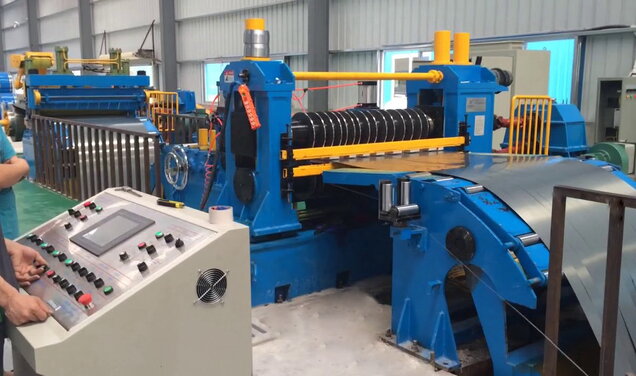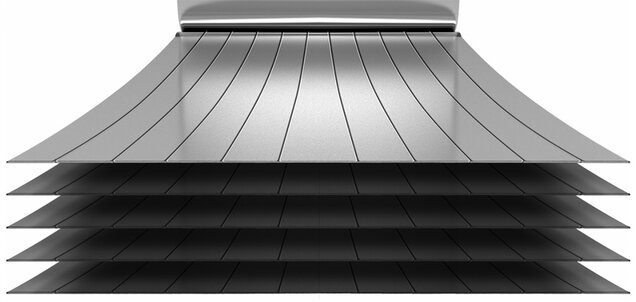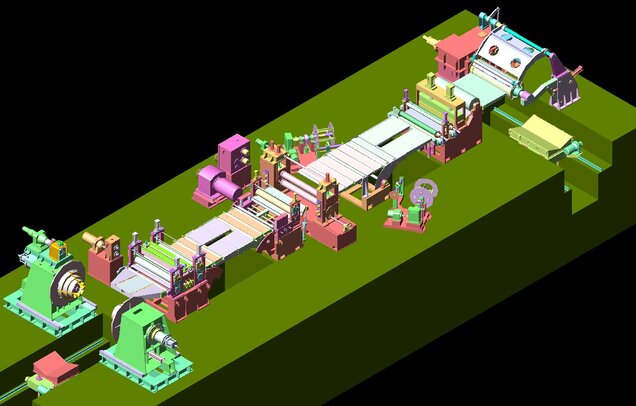Steel Slitting Lines
Metal sheets or strips suppliers always need slitting machine and cut to length machine line for the production of metal sheets with different widths or lengths from GI (galvanised iron), PPGI - PPGL (pre-painted galvanised iron), PCI (pre-coated steel) or stainless coils in large quantities.
A steel mill most of time produces only wide steel coils, and steel or metal fabricators always use a slitting and cut to length machine line to manufacture steel strips with different widths or metal sheets with fixed lengths. A metal slitting machine line has been designed to cut longitudinally the wide steel coils into different narrow steel strips for continuously producing cold formed sectional steel products.
Basically there are two types: high-speed and normal-speed slitting machine line. A High-speed slitter can works at max speed over 150 m/minute and over 10 strips can be produced; while a normal-speed slitting machine can work at most 40m/min with less than 10 strips slit.
Sheet metal coil slitting lines production.
Everything from highway rails, to HVAC components, to automotive components and possibly some of our kitchen appliances were produced using sheet metal coil slitting lines, cut to length lines, or punch press lines.

Längsteilanlagen
Wir liefern Längsteilanlagen, die in der Lage sind, die Anforderungen der unterschiedlichsten Kunden zu erfüllen
Äußerst leistungsstarke und flexible Linien für Coils bis zu 45 t und mit einer Betriebsgeschwindigkeit bis zu 400 m/min, die für Stahlwerke, Service-Center, die Automobilindustrie und vieles mehr geeignet sind. Kompakte, einfache und äußerst flexible Linien für eine geringere Produktionskapazität.
Unsere Längsteilanlagen sind für die Bearbeitung von Materialien mit einer maximalen Breite von 2200 mm und einer Stärke zwischen 0,2 und 20 mm geeignet und zeichnen sich durch die Qualität des Endprodukts aus.
Unsere Produktionspalette umfasst:
- Längsteilanlage für geringe Stärken
- Längsteilanlage für mittlere Stärken
- Längsteilanlage für große Stärken
- Verpackungslinien für Bänder
Mit unseren Längsteilanlagen können verschiedenen Materialien bearbeitet werden:
- warm- oder kaltgewalzter Stahl
- verzinkter, vorlackierter Stahl
- hochfester Stahl
- Edelstahl
- Aluminium
- Kupfer
- Zink
- Legierungen
Wir lenken besonders große Aufmerksamkeit auf die Funktionstüchtigkeit und die Zweckmäßigkeit der Ausrüstungen, um dadurch die Vorbereitungszeiten der Anlage auf ein Minimum reduzieren zu können.
Je nach Typ der Längsteilanlage können wir Folgendes anbieten:
- Automatische Coilzuführung
- Automatischer Zuschnitt des Coilendes
- Automatischer Wechsel des Kopfs der Rundmesserschere – Shuttle System
- Automatischer Messerwechsel mit Drehkopf
- Automatische robotergesteuerte Zusammenstellung des Messerpakets
- Automatische Messerverriegelung
- System zur Aufwicklung des Bandabfalls oder Saumstreifenschneider
- System mit beweglichem Bremsschlitten
- Bremsvorrichtung des Bands mit verschiedenen Systemen, ja nach Materialtyp und -oberfläche
- Automatische Bandstreifenseparierung
- Automatische Verarbeitung der Bandenden
- Mobile Greifer zur automatischen Einführung des Bandendes in die Spannbacke der Aufwickelhaspel
- Automatische Coilentladung
- Integrierte Umreifungssysteme
Alle unsere Längsteilmaschinen sind mit einer von unserer technischen Abteilung entwickelten Software ausgestattet. Sie ermöglicht die Kommunikation mit den Verarbeitungssystemen des Kunden, die Verbindung mit automatischen Systemen zum Werkzeugwechsel sowie mit der Verpackungslinie für Bänder, sofern vorhanden. Außerdem stehen ein „Fern-Kundendienst“ für die Kontrolle der Anlage und die Fernwartung zur Verfügung.
Slitting line for metal coils
Slitting line for coils, metal coils. For widths of up to 2200 mm, thicknesses of up to 18 mm and speeds of up to 400 m/min. The lines are composed of high-precision slitters with quick tooling change for slitter, tensioning device and recoiler. Lines are offered with scrap ballers or scrap choppers. Moving tensioning devices with incorporated levelling. Lines are suitable to process materials used in the automotive and appliance industry, such as stainless steel, pre-painted, cold rolled steel, hot rolled carbon steel, electric steel, copper, brass and titanium.
Pressmach covers 3 Ranges of slitting lines
THIN GAUGE SLITTING LINE
Lines dedicated to small thicknesses at high speed.
TECHNICAL DATA
| Coils | 10 ÷ 30 Tons |
| Thickness | 0.2 ÷ 4 mm |
| Width | 200 ÷ 2200 mm |
| Speed | 200 ÷ 500 m/min |
MEDIUM GAUGE SLITTING LINES
Slitting Lines for high production.
TECHNICAL DATA
| Coils | 15 ÷ 42 Tons |
| Thickness | 0,5 ÷ 12mm |
| Width | 500 ÷ 2200 mm |
| Speed | 100 ÷ 200 m/min |
HEAVY GAUGE SLITTING LINES
Slitting lines for coils.
TECHNICAL DATA
| Coils | 18÷ 60 Tons |
| Thickness | 3 ÷ 18 mm |
| Width | 800 ÷ 2200 mm |
| Speed | 40 ÷ 100 m/min |

Slitting Lines
Working with Sheet Metal Coils
What is a Sheet Metal Coil Slitting Line?
The most basic explanation of what a metal coil slitting (or cutting line) does is, it take enormous rolls (or coils) of precisely created metal and creates smaller sheets and cut sections from the master coil. Sometimes these lines provide appearance treatments, and quality modifications for the metal.
Though the process may seem about as simple as unrolling a sheet of paper towels, there is a tremendous emphasis on accuracy and precision for each step of the sheet metal coil handling/slitting process.
The reason there is such precision required for this process is because final customers depend on receiving metal products from the line that meet tolerances often of .01 per inch or less. Additionally, the coatings which are applied during the metal slitting and unrolling process must also be very precise tolerances.
Components of a Metal Coil Slitting Line
The general layout of a sheet metal coil slitting line includes the following stations and processes:
#1 Coil handling equipment for loading metal coils onto and off of the various metal slitting and processing line.
Metal coils can weigh many tons depending on the type, gage, dimension and quality of metal being slit. Special lifts remove the metal coils from either tractor-trailers or railroad cars. They are then transported to the first stage of the metal coil line, the uncoiler, with the help of robotic coil handling carts or specially equipped lift trucks.
Once at the station for uncoiling, the coils can be hoisted into position on to a feeding capstan or directly into the coil processing machine with upenders, hoists, cranes, forklifts, and sometimes onto turnstiles for staging onto the uncoiler.
#2 The use of Uncoilers for unrolling the coil and controlling the speed of the metal coil into the slit processing line
The uncoiling machine is generally the first step of active coil processing on a metal coil slitting or processing line. It feeds the coil at carefully regulated and synchronized speed into the processing line, so that there are no deformations introduced unnecessarily by the uncoiling process.
Depending on the form of the line there may be a direct feed from the uncoiling machine into the levelers, tensioners, edge trimmers, even a portion of the uncoiled metal is allowed to run slack. This is to assist with line regulation and minimizing metal deformation.
#3 Different processing and shaping steps including levelers, feeders, edge trimmers, sheers, punch presses, peelers, straighteners, and notchers.
There are an almost limitless number of operations that can be performed on a metal slitting and cutting line. Some of these operations are designed to improve the accuracy of the final product, others are designed to improve the appearance, or characteristics of the metal for resisting corrosion and other factors.
Some of the processes for minimizing deformation and producing the most accurate slitting product, include cut to length, load leveling, tensioners, edge trimmers, in addition to presses and straighteners.
Other lines will add surface preparation such as pickling, acid baths, electroplating, galvanizing, and a variety of surface preparations.
#4 The recoiling equipment for those products that will be shipped in coil form, or sheet unloading equipment and stackers for products that will be sold in sheet or flat form.
The final product from a metal coil slitting line could either be smaller dimension coils, cut to length metal sheets, or possibly another coil that has been fully coated with a special surface preparation.
Each one of these steps that composes a metal coil slitting or cut to length line will also have multiple controls and often automation built in to ensure the high precision product required of the metals slitting and coiling industry.
By understanding the basic components that go into a sheet metal slitting and cutting line, it is easier to understand the factors that affect the performance as well as the cost of these industrial production facilities.


